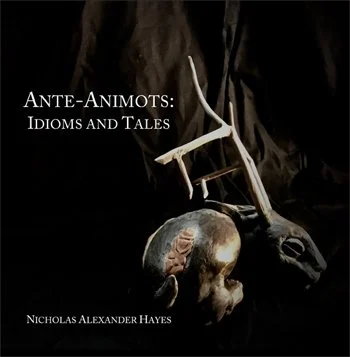Ante-Animots: Idioms and Tales by Nicholas Alexander Hayes
These idioms and tales use language as a tool to lift a hazy film away from our perception and replace it with another. Is it surgery or a theater of cruelty, a catastrophe or a joke? It’s an intervention into both the real and the imaginary—not to show us that one lies beneath the other or hidden inside like a nested doll, but to remind us that animals are composed of wounds and words and that all of us are dying. It isn’t pretty, and it is. It isn’t imaginary, and none of it is real. It’s a vicious and lyrical, lucid and fantastical, vast little book. – Stephen Beachy
These idioms and tales use language as a tool to lift a hazy film away from our perception and replace it with another. Is it surgery or a theater of cruelty, a catastrophe or a joke? It’s an intervention into both the real and the imaginary—not to show us that one lies beneath the other or hidden inside like a nested doll, but to remind us that animals are composed of wounds and words and that all of us are dying. It isn’t pretty, and it is. It isn’t imaginary, and none of it is real. It’s a vicious and lyrical, lucid and fantastical, vast little book. – Stephen Beachy
These idioms and tales use language as a tool to lift a hazy film away from our perception and replace it with another. Is it surgery or a theater of cruelty, a catastrophe or a joke? It’s an intervention into both the real and the imaginary—not to show us that one lies beneath the other or hidden inside like a nested doll, but to remind us that animals are composed of wounds and words and that all of us are dying. It isn’t pretty, and it is. It isn’t imaginary, and none of it is real. It’s a vicious and lyrical, lucid and fantastical, vast little book. – Stephen Beachy
These idioms and tales use language as a tool to lift a hazy film away from our perception and replace it with another. Is it surgery or a theater of cruelty, a catastrophe or a joke? It’s an intervention into both the real and the imaginary—not to show us that one lies beneath the other or hidden inside like a nested doll, but to remind us that animals are composed of wounds and words and that all of us are dying. It isn’t pretty, and it is. It isn’t imaginary, and none of it is real. It’s a vicious and lyrical, lucid and fantastical, vast little book.
– Stephen Beachy, author of Glory Hole
Nicholas Hayes writes intuitive poetry, and is, in a rather Dickinsonian manner, keen to define and re-define things, including certain behaviour patterns of humans and animals alike. I see this collection as a “reversed” Manual de zoología fantástica by Borges, in the sense that, instead of describing imaginary beings, Hayes gives a hallucinatory account of some familiar creatures playing out their very own grotesque.
– Anatoly Kudryavitsky, author of The Flying Dutchman
Reading Nicholas Alexander Hayes’s Ante-Animots feels like a whole other zoological expedition but in the circus cage of language itself. Verbs and nouns and adjectives twist and turn in delightful and occasionally forceful ways, particularly if one reads these pieces out loud. It is then one feels that rarified space between spectator and spectacle.
– Raymond Luczak, author of A Babble of Objects: Poems
Nicholas Alexander Hayes is a Chicago-based writer, artist, and educator. Across literature and visual work, he engages in serious play through re-mixing and erasure. His creative and academic interests include ’60s gay pulp fiction, vintage beer advertisements, depictions of masculinity on social media, ancient history and whatever pieces of cultural detritus catch his eye.
Book Information:
· Paperback: 82 pages
· Binding: Perfect-Bound
· Publisher: BlazeVOX [books]
· ISBN: 978-1-60964-342-3
